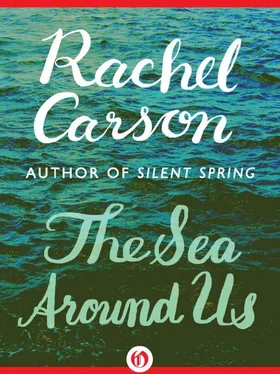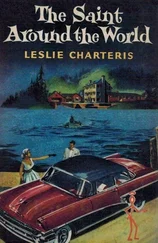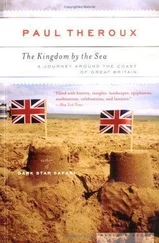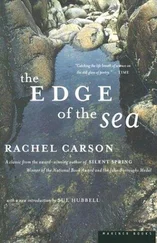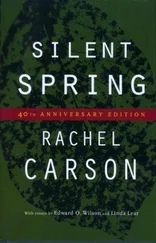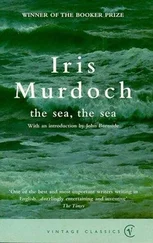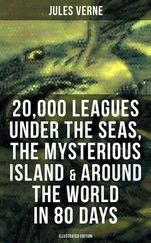Chiefly at night, but occasionally in broad daylight, a shoal of small squids shot out of the water precisely like flying fish, gliding through the air as much as up to six feet above the surface, until they lost the speed accumulated below water, and fell down helplessly. In their gliding flight with flaps out they were so much like small flying fish at a distance, that we had no idea we saw anything unusual until a live squid flew right into one of the crew and fell down on the deck. Almost every night we found one or two on the deck or on the roof of the bamboo hut.
It was my own definite impression that the marine life in general went deeper down in the daytime than during the nights, and that the darker the night was, the more life we had around us. At two different occasions, a snake-mackerel, Gempylus, never before seen by man except as skeletal remains washed ashore on South America and the Galapagos, came jumping clear out of the water and right up on the raft (once right into the hut). To judge from the huge eyes and the fact that the fish has never before been observed, I am inclined to suspect that it is a deep-sea fish that comes to the surface only at night.
On dark nights we could see much marine life which we were unable to identify. They seemed to be deep-sea fishes approaching the surface at night. Generally we saw it as vaguely phosphorescent bodies, often the size and shape of a dinner plate, but at least one night in the shape of three immense bodies of irregular and changing shape and dimensions which appeared to exceed those of the raft (Kon-Tiki measured about 45 by 18 feet). Apart from these greater bodies, we observed occasionally great quantities of phosphorescent plankton, often containing illuminating copepods up to the size of a millimeter or more.
With these surface waters, through a series of delicately adjusted, interlocking relationships, the life of all parts of the sea is linked. What happens to a diatom in the upper, sunlit strata of the sea may well determine what happens to a cod lying on a ledge of some rocky canyon a hundred fathoms below, or to a bed of multicolored, gorgeously plumed seaworms carpeting an underlying shoal, or to a prawn creeping over the soft oozes of the sea floor in the blackness of mile-deep water.
The activities of the microscopic vegetables of the sea, of which the diatoms are most important, make the mineral wealth of the water available to the animals. Feeding directly on the diatoms and other groups of minute unicellular algae are the marine protozoa, many crustaceans, the young of crabs, barnacles, sea worms, and fishes. Hordes of the small carnivores, the first link in the chain of flesh eaters, move among these peaceful grazers. There are fierce little dragons half an inch long, the sharp-jawed arrow-worms. There are gooseberrylike comb jellies, armed with grasping tentacles, and there are the shrimplike euphausiids that strain food from the water with their bristly appendages. Since they drift where the currents carry them, with no power or will to oppose that of the sea, this strange community of creatures and the marine plants that sustain them are called ‘plankton,’ a word derived from the Greek, meaning ‘wandering.’
From the plankton the food chains lead on, to the schools of plankton-feeding fishes like the herring, menhaden, and mackerel; to the fish-eating fishes like the bluefish and tuna and sharks; to the pelagic squids that prey on fishes; to the great whales who, according to their species but not according to their size, may live on fishes, on shrimps, or on some of the smallest of the plankton creatures.
Unmarked and trackless though it may seem to us, the surface of the ocean is divided into definite zones, and the pattern of the surface water controls the distribution of its life. Fishes and plankton, whales and squids, birds and sea turtles, all are linked by unbreakable ties to certain kinds of water—to warm water or cold water, to clear or turbid water, to water rich in phosphates or in silicates. For the animals higher in the food chains the ties are less direct; they are bound to water where their food is plentiful, and the food animals are there because the water conditions are right.
The change from zone to zone may be abrupt. It may come upon us unseen, as our ship at night crosses an invisible boundary line. So Charles Darwin on H.M.S. Beagle one dark night off the coast of South America crossed from tropical water into that of the cool south. Instantly the vessel was surrounded by numerous seals and penguins, which made such a bedlam of strange noises that the officer on watch was deceived into thinking the ship had, by some miscalculation, run close inshore, and that the sounds he heard were the bellowing of cattle.
To the human senses, the most obvious patterning of the surface waters is indicated by color. The deep blue water of the open sea far from land is the color of emptiness and barrenness; the green water of the coastal areas, with all its varying hues, is the color of life. The sea is blue because the sunlight is reflected back to our eyes from the water molecules or from very minute particles suspended in the sea. In the journey of the light rays into deep water all the red rays and most of the yellow rays of the spectrum have been absorbed, so when the light returns to our eyes it is chiefly the cool blue rays that we see. Where the water is rich in plankton, it loses the glassy transparency that permits this deep penetration of the light rays. The yellow and brown and green hues of the coastal waters are derived from the minute algae and other microorganisms so abundant there. Seasonal abundance of certain forms containing reddish or brown pigments may cause the ‘red water’ known from ancient times in many parts of the world, and so common is this condition in some enclosed seas that they owe their names to it—the Red Sea and the Vermilion Sea are examples.
The colors of the sea are only the indirect signs of the presence or absence of conditions needed to support the surface life; other zones, invisible to the eye, are the ones that largely determine where marine creatures may live. For the sea is by no means a uniform solution of water; parts of it are more salty than others, and parts are warmer or colder.
The saltiest ocean water in the world is that of the Red Sea, where the burning sun and the fierce heat of the atmosphere produce such rapid evaporation that the salt content is 40 parts per thousand. The Sargasso Sea, an area of high air temperatures, receiving no inflow of river water or melting ice because of its remoteness from land, is the saltiest part of the Atlantic, which in turn is the saltiest of the oceans. The polar seas, as one would expect, are the least salty, because they are constantly being diluted by rain, snow, and melting ice. Along the Atlantic coast of the United States, the salinity range from about 33 parts per thousand off Cape Cod to about 36 off Florida is a difference easily perceptible to the senses of human bathers.
Ocean temperatures vary from about 28° F. in polar seas to 96 ° in the Persian Gulf, which contains the hottest ocean water in the world. To creatures of the sea, which with few exceptions must match in their own bodies the temperature of the surrounding water, this range is tremendous, and change of temperature is probably the most important single condition that controls the distribution of marine animals.
The beautiful reef corals are a perfect example of the way the inhabitable areas for any particular class of creatures may be established by temperatures. If you took a map of the world and drew a line 30° north of the equator and another 30° south of it, you would have outlined in general the waters where reef corals are found at the present time. It is true that the remains of ancient coral reefs have been discovered in arctic waters, but this means that in some past ages the climate of these northern seas was tropical. The calcareous structure of the coral reef can be fashioned only in water at least as warm as 70° Fahrenheit. We would have to make one northward extension of our map, where the Gulf Stream carries water warm enough for corals to Bermuda, at 32° north latitude. On the other hand, within our tropical belt, we would have to erase large areas on the west coasts of South America and Africa, where upwelling of cold water from lower ocean levels prevents the growth of corals. Most of the east coast of Florida has no coral reefs because of a cool inshore current, running southward between the coast and the Gulf Stream.
Читать дальше
